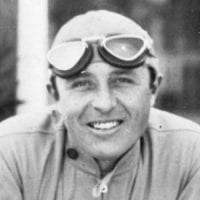Pierre Veyron was not a top-rank driver but his name adorns the fastest road car in the world today – the 16.4-litre Bugatti Veyron. Winner of the 1939 Le Mans 24 Hours, it was in voiturettes that the tall, thickset and blond Veyron excelled.
Background and early racing career
Trained as an engineer, he was already 27-years-old when Albert Divo persuaded him to try racing. His mentor introduced Veyron to Amiens-based industrialist and amateur racing driver André Vagniez who financed his early career.
Veyron first competed on the 1930 Mount Ventoux hillclimb with an EHP before switching to circuit racing a year later with a 1500cc Bugatti T37A – winning the voiturette qualifying heat at Geneva and finishing second at St Gaudens. Vagniez invested in a new Maserati 26C for 1932 and Veyron responded with another class win in Casablanca and outright successes in the 1500cc races that supported the Lorraine and Comminges Grands Prix at Nancy and St Gaudens respectively.
Voiturette racing with Bugatti
Those performances were noted in Molsheim and Veyron joined Bugatti for 1933. Two glorious years in the 1500cc voiturette class began with victory at Avus – his Bugatti T51 humbling the local entry in front of the newly elected Adolf Hitler. Watching a French car win in Berlin prompted the Reich Chancellor to finance Germany’s GP renaissance a year later.
Veyron only raced in two voiturette events in 1934 (winning both), preferring to race a privately-entered T51 in the GP class. He finished ninth on his GP debut at Monaco but more often raced in France’s minor races with third at Albi his best result. However, the arrival of Mercedes-Benz and Auto Union rendered Bugatti’s GP cars obsolete.
Winner of the 1939 Le Mans 24 Hours
Without hope of success in their own GP, the Automobile Club de France switched the race to sports car rules in 1936 and Veyron finished sixth when sharing a Bugatti T57S with “W.Williams”. Three appearances in the Le Mans 24 Hours only yielded disappointment before he partnered Jean-Pierre Wimille in the sole works Bugatti T57C in 1939 – winning at an average of 86.85mph.
Veyron, Wimille and “Williams” all fought in the same Resistance cell during World War II. His colleagues were both captured and executed but Veyron survived the conflict. He received the Croix de Guerre in 1945 in recognition of his bravery and resumed his racing career. Veyron retired from racing after the 1954 Le Mans 24 Hours and settled on the French Riviera where he ran a manufacturing company that specialised in oil drilling technology.


